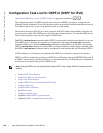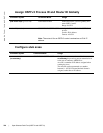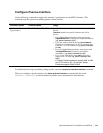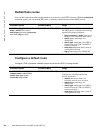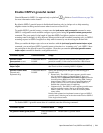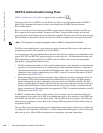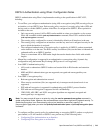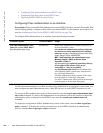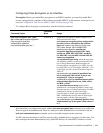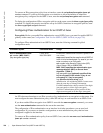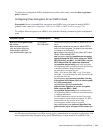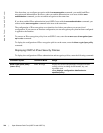
734 | Open Shortest Path First (OSPFv2 and OSPFv3)
www.dell.com | support.dell.com
OSPFv3 Authentication Using IPsec
OSPFv3 Authentication Using IPsec is supported only on platform: e
t
Starting in release 8.4.2.0, OSPFv3 uses the IP Security (IPsec) to provide authentication for OSPFv3
packets. IPsec authentication ensures security in the transmission of OSPFv3 packets between
IPsec-enabled routers.
IPsec is a set of protocols developed by the IETF to support secure exchange of packets at the IP layer.
IPsec supports two encryption modes: Transport and Tunnel. Transport mode encrypts only the data
portion (payload) of each packet, but leaves the header untouched. The more secure Tunnel mode encrypts
both the header and the payload. On the receiving side, an IPsec-compliant device decrypts each packet.
With IPsec-based authentication, crypto images are used to include the IPsec secure socket application
programming interface (API) required for use with OSPFv3.
To ensure integrity, data origin authentication, detection and rejection of replays, and confidentiality of the
packet, RFC 4302 and RFC 4303 propose using two security protocols - AH (authentication header) and
ESP (encapsulating security payload). For OSPFv3, these two IPsec protocols provide interoperable,
high-quality cryptographically-based security.
• The IPsec authentication header is used in packet authentication to verify that data is not altered during
transmission and ensures that users are communicating with the intended individual or organization.
The authentication header is inserted after the IP header with a value of 51. AH provides integrity and
validation of data origin by authenticating every OSPFv3 packet. For detailed information on the IP
AH protocol, refer to RFC 4302.
• The encapsulating security payload encapsulates data, enabling the protection of data that follows in
the datagram. ESP provides authentication and confidentiality of every packet. The ESP extension
header is designed to provide a combination of security services for both IPv4 and IPv6. The ESP
header is inserted after the IP header and before the next layer protocol header in transport mode. It is
possible that the ESP header is inserted between the next layer protocol header and encapsulated IP
header in tunnel mode. The tunnel mode is not supported in FTOS. For detailed information on the IP
ESP protocol, refer to RFC 4303.
In OSPFv3 communication, IPsec provides security services between a pair of communicating hosts or
security gateways using either AH or ESP. In an authentication policy on an interface or in an OSPF area,
AH and ESP are used alone; in an encryption policy, AH and ESP may be used together. The difference
between the two mechanisms is the extent of the coverage. ESP only protects IP header fields if they are
encapsulated by ESP.
The set of IPsec protocols that are employed for authentication and encryption and the ways in which they
are employed is user-dependent. When IPsec is correctly implemented and deployed, it does not adversely
affect users or hosts. AH and ESP are designed to be cryptographic algorithm-independent.
Note: FTOS supports only transport encryption mode in OSPFv3 authentication with IPsec.



